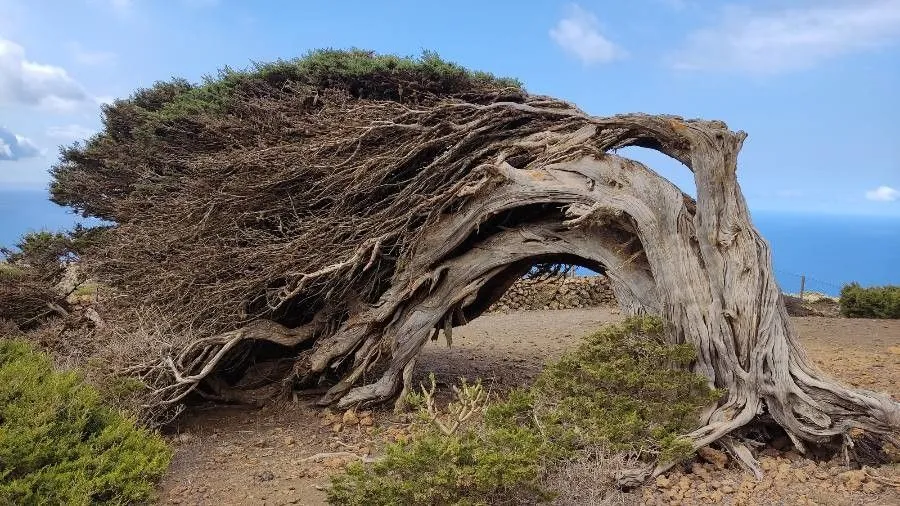
Author: L.
Bibliography: Sp. Pl.: 1039 (1753)
Year: 1753
Status: accepted
Rank: species
Genus: Juniperus
Vegetable: False
Observations: S. France to Spain, Corse, Morocco to N. Algeria
The Incense Juniper is a distinguished and unique plant known scientifically as Juniperus thurifera. Initially described in 1753, this species is a charismatic member of the Cupressaceae family. The Incense Juniper is recognized for its distinct characteristics and adaptability, thriving across various regions including Southern France, Spain, Corsica, Morocco, and Northern Algeria.
The name “Incense Juniper” alludes to the historical use of its fragrant wood, especially for incense and other aromatic applications. This coniferous tree is notable for its dense, evergreen foliage and roughly textured bark, which endures a myriad of environmental conditions. Adapted to its Mediterranean climate, the Incense Juniper often grows on rocky hillsides and dry, infertile soils that most plants find challenging.
Ecologically, Juniperus thurifera serves a significant role in its native habitats. Its hardy nature makes it a crucial stabilizing species in preventing soil erosion, while also providing habitats and food for various wildlife species. Its berries, although aromatic, are a key food source for birds and mammals in these arid regions.
The tree itself exhibits a majestic stature, often reaching elevations between 10 to 25 meters in height. Its foliage typically consists of small, scale-like leaves, which can vary in color from a deep green to a silvery-blue hue. These leaves are densely packed along the branches, creating a robust and visually striking canopy.
Cultivated for both its ornamental and practical uses, the Incense Juniper is valued in landscaping for its resilience and aesthetic appeal. Moreover, its wood is highly sought after not just for its aromatic quality, but also for its durability and resistance to decay.
In summary, the Incense Juniper (Juniperus thurifera) stands as a testament to botanical resilience and ecological importance. Its broad native range from the Mediterranean regions of Europe to the mountains of North Africa showcases its adaptability and essential role in diverse ecosystems. The legacy of this venerable species, recorded meticulously over centuries, continues to flourish as it contributes to both natural landscapes and human appreciation for nature’s enduring beauty.
Ara: arâr
Eng: incense juniper, spanish juniper
Deu: spanische zeder, weihrauch-sadebaum, weihrauch-wacholder
Spa: cedro de españa, enebro, sabina albar, sabina blanca, trabina
Fra: genévrier à l’encens
En: Incense juniper, Spanish juniper, French Alpine Juniper
Ar: Aoual, Araâr, عرعار فواح, Arâr
Eu: Intsentsu-sabina
Ca: Savina turífera
Eo: Incensa junipero
Fi: Espanjankataja
Fr: Genévrier thurifère, Genévrier à l’encens, Genévrier à encens, Cèdre d’Espagne, Genévrier à résine odorante, Genévrier d’Espagne, Genévrier de France
De: Spanischer Wacholder, Spanische Zeder, Weihrauch-Sadebaum, Weihrauch-Wacholder, Weihrauchtragender Wacholder, Weihrauchwacholder
Is: Spánareinir
It: Ginepro turifero, Ginepro spaniolo
No: Spansk einer
Fa: ارس اسپانیایی
Ru: Можжевельник ладанный
Es: Cedro de España, Trabina, Enebro, Sabina blanca, Sabina albar
Taken May 2, 2022 by Andrzej Konstantynowicz (cc-by-sa)
Taken Nov 1, 2017 by Marcos Rivas Campoamor (cc-by-sa)
Taken Nov 1, 2017 by Marcos Rivas Campoamor (cc-by-sa)
Taken Nov 1, 2017 by Marcos Rivas Campoamor (cc-by-sa)
Taken Apr 19, 2018 by Marcos Rivas Campoamor (cc-by-sa)
Taken Oct 31, 2017 by Marcos Rivas Campoamor (cc-by-sa)
Taken Mar 7, 2018 by Marcos Rivas Campoamor (cc-by-sa)
Taken Dec 9, 2020 by Palo Rapos (cc-by-sa)
Taken Dec 9, 2020 by Palo Rapos (cc-by-sa)
Taken Oct 20, 2017 by Marcos Rivas Campoamor (cc-by-sa)
© copyright of the Board of Trustees of the Royal Botanic Gardens, Kew.
© copyright of the Board of Trustees of the Royal Botanic Gardens, Kew.
Taken Jul 8, 2015 by Tela Botanica − Yoan MARTIN (cc-by-sa)
Taken Jul 8, 2015 by Tela Botanica − Yoan MARTIN (cc-by-sa)
Taken Sep 8, 2021 by Martín López Raúl (cc-by-sa)
Taken Sep 6, 2021 by Francois Mansour (cc-by-sa)
Taken Dec 9, 2020 by Palo Rapos (cc-by-sa)
Taken Jul 8, 2015 by Tela Botanica − Yoan MARTIN (cc-by-sa)
Taken Jul 8, 2015 by Tela Botanica − Yoan MARTIN (cc-by-sa)
Taken Jul 8, 2015 by Tela Botanica − Yoan MARTIN (cc-by-sa)
Taken Sep 6, 2021 by Francois Mansour (cc-by-sa)
Taken Nov 12, 2021 by Begoña Sanz (cc-by-sa)
Taken Jul 11, 2013 by Tela Botanica − Stéphane DELPLANQUE (cc-by-sa)
Taken Jul 11, 2013 by Tela Botanica − Stéphane DELPLANQUE (cc-by-sa)
Taken Jul 11, 2013 by Tela Botanica − Stéphane DELPLANQUE (cc-by-sa)
Taken Jul 8, 2015 by Tela Botanica − Yoan MARTIN (cc-by-sa)
Taken Jul 8, 2015 by Tela Botanica − Yoan MARTIN (cc-by-sa)
Taken Apr 14, 1988 by Tela Botanica − Liliane Roubaudi (cc-by-sa)
Taken Apr 14, 1988 by Tela Botanica − Liliane Roubaudi (cc-by-sa)
Taken Jan 1, 1970 by Photoflora – L’Abbé COSTE (©)
Taken Jul 11, 2014 by Tela Botanica − Liliane Roubaudi (cc-by-sa)
Taken Jul 8, 2015 by Tela Botanica − Yoan MARTIN (cc-by-sa)
Growth habit: Tree
Ph maximum: 7.0
Ph minimum: 6.5
Light: 8
Atmospheric humidity: 3
Bloom months: [‘feb’, ‘mar’]
Soil nutriments: 2
Family: Myrtaceae Author: (F.Muell.) K.D.Hill & L.A.S.Johnson Bibliography: Telopea 6: 402 (1995) Year: 1995 Status:…
Family: Rubiaceae Author: Pierre ex A.Froehner Bibliography: Notizbl. Bot. Gart. Berlin-Dahlem 1: 237 (1897) Year:…
Family: Sapindaceae Author: Koidz. Bibliography: J. Coll. Sci. Imp. Univ. Tokyo 32(1): 38 (1911) Year:…
Family: Asteraceae Author: A.Gray Bibliography: Pacif. Railr. Rep.: 107 (1857) Year: 1857 Status: accepted Rank:…
Family: Fabaceae Author: Medik. Bibliography: Vorles. Churpfälz. Phys.-Ökon. Ges. 2: 398 (1787) Year: 1787 Status:…
Family: Aspleniaceae Author: (Cav.) Alston Bibliography: Bull. Misc. Inform. Kew 1932: 309 (1932) Year: 1932…